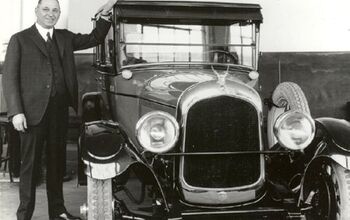Chrysler Suicide Watch 50: RIP

Chrysler’s logo should have been a bottle of lithium, rather than the Pentastar. It suffered from severe bipolar disorder all its life, and, sadly, died from it at its own hands. Like many suicidal bipolars (e.g., Van Gogh, Hemingway, Virgina Woolf), Chrysler’s many crashes and acts of self-mutilation were punctuated by fantastic highs of brilliant engineering, design and creativity. Chrysler has taken us on quite the roller coaster ride. And now it’s over. As we stumble out of our (Hemi-powered) coaster car, we’re left with an intense mixture of relief, thrill, and sadness.
Chrysler’s beginning was an unparalleled flash of genius and overnight success. Walter P. Chrysler had a fairy-tale career in the early automobile business, earning $10 million ($130 million today) in just three years while turning Buick into GM’s early powerhouse. Then, while running Maxwell, he launched the Chrysler line in 1924 with that just-perfect blend of advanced engineering and style.
It was a home run that catapulted Chrysler to number four out of a crowded field of 49 manufacturers. The subsequent successful launches of the low-price Plymouth, the upper-mid priced DeSoto, and the purchase of mid-priced Dodge firmly established Chrysler as a charter member of the Big Three.
Chrysler’s first crisis came in 1934 with the failure of the radically advanced but unusual-looking Airflow. Its wholesale rejection by the buying public taught Chrysler (and Detroit) a painful lesson: avoid extreme innovation.
Chrysler recuperated and made enormous profits during the WWII era. But the development of the all-new 1949 models was haunted by Chrysler’s still-lingering Airflow insecurities. Whereas GM and Ford confidently introduced longer and lower models designed to thrill exuberant post-was buyers, Chrysler president P. T. Keller insisted on tall, boxy cars.
In the early fifties, Americans were in the mood for more—horsepower, automatics, power steering and brakes, style, and flash. Unlike Chevy and Ford, Plymouth offered none of those, and the market punished it unmercifully. In 1954, Plymouth was kicked out of its long-established number three spot by Buick and dropped to number five behind Pontiac.
The exuberant designer Virgil Exner was hired to inject vitality and fresh style. The 1955s were an improvement, but the radical 1957s were destined to be the great leap forward (“suddenly it’s 1960!”). But in the rush to revolutionize, the products were not fully developed, and suffered from atrocious build quality.
The flashy ’57s sold, but word got out and buyers punished Chrysler unmercifully. 1958 sales plunged by no less than 41% for Plymouth. And despite a reputation for engineering excellence, Chrysler would have to dodge a reputation for spotty build quality from then on, deserved or not.
Chrysler nursed itself to health once more, only to be deeply wounded by one of the most staggeringly idiotic acts of executive self-mutilation. In 1960, Chrysler president William Newberg overheard a rumor at a cocktail party that Chevrolet was working on a dramatically smaller 1962 model (it was: the compact Chevy II).
In a colossal blunder, he assumed this referred to the full-sized Chevrolets. Newberg killed development of the full size 1962 Plymouths and Dodges and initiated a crash program for substantially downsized replacements. When the ugly, truncated ’62s were first shown to dealers, an uproar ensued, and twenty dealers cancelled their franchises on the spot. Plymouth crashed to ninth place, while GM’s market share rose to an all-time peak of 52%.
Chrysler barely survived the fiasco but went on to enjoy a relatively long spell of good health from the mid-60s through 1974, in part thanks to its successful performance image. But with a portfolio of heavy RWD cars and lacking the foresight, will (and capital) to retool extensively, Chrysler was flattened by the one-two punch of the energy crises. By 1979, it was back on the critical list, saved from bankruptcy only by the life-support of a government loan-guarantee act.
This financed the compact K-car; Chrysler squeaked by and regained health, once again. Endless K-car variants carried the day. When the 1990 recession brought on another depression, Iaccoca was shown the door.
In the mid-nineties, Chrysler was on its ultimate manic high. Low overhead costs from its near-bankruptcy, some deft model development, the purchase of Jeep, and sheer luck (the boom of the truck and SUV markets) generated huge profits and a 23% market share in 1997 (bigger than GM’s recently). But at the very height of health and success, the suicidal urges return.
In 1998, CEO Robert Eaton had Chrysler engage in ritual corporate seppuku by selling itself to Daimler (while walking away with over $200 million himself). And despite all of Dr. Z’s ministrations, the patient never really regained lasting health. Was there arsenic in the Daimler medicine?
There’s a market for corpses, and Cerberus bit with all three heads at once. And choked.

More by Paul Niedermeyer
Latest Car Reviews
Read moreLatest Product Reviews
Read moreRecent Comments
- Wjtinfwb 157k is not insignificant, even for a Honda. A lot would depend on the maintenance records and the environment the car was operated in. Up to date maintenance and updated wear items like brakes, shocks, belts, etc. done recently? Where did those 157k miles accumulate? West Texas on open, smooth roads that are relatively easy on the chassis or Michigan, with bomb crater potholes, snow and salt that take their toll on the underpinnings. That Honda 4 will run forever with decent maintenance but the underneath bits deteriorate on a Honda just like they do on a Chevy.
- Namesakeone Yes, for two reasons: The idea of a robot making decisions based on algorithms does not seem to be in anyone's best interest, and the thought of trucking companies salivating over using a computer to replace the salary of a human driver means a lot more people in the unemployment lines.
- Bd2 Powertrain reliability of Boxer engines is always questionable. I'll never understand why Subaru held onto them for so long. Smartstream is a solid engine platform as is the Veracruz 3.8L V6.
- SPPPP I suppose I am afraid of autonomous cars in a certain sense. I prefer to drive myself when I go places. If I ride as a passenger in another driver's car, I can see if that person looks alert and fit for purpose. If that person seems likely to crash, I can intervene, and attempt to bring them back to attention. If there is no human driver, there will probably be no warning signs of an impending crash.But this is less significant than the over-arching fear of humans using autonomous driving as a tool to disempower and devalue other humans. As each generation "can't be trusted" with more and more things, we seem to be turning more passive and infantile. I fear that it will weaken our society and make it more prone to exploitation from within, and/or conquest from the outside.
- JMII Based on the human drivers I encounter everyday I'll happily take my chances with a computer at the wheel.The highway driver assist system on my Santa Cruz is great, it can self drive perfectly in about 90% of situations. However that other 10% requires you to be in control and make decisions. I feel this is the problem with an AI driving a car, there are times when due to road construction, weather conditions or other drivers when only a human will know what to do.


































Comments
Join the conversation
One of the primary things that had kept Chrysler afloat through all the mistakes for so many years was the military division. Ever since WWII, Chrysler management could screw up as badly as they wanted so long as the military division cash-cow continued to churn out tanks for the US military. But then came the seventies' crisis and Iacocca. Lido has said in his first book that one of the most difficult decisions he had to make to keep Chrysler going was whether to continue building cars or military vehicles. Ultimately, it was the military division that went. It was the right decision for the time but, in the long run, not having the military division for the company to fall back on through the rough periods (as it had so many times in the past) would ultimately spell its doom.